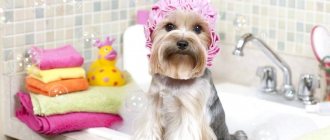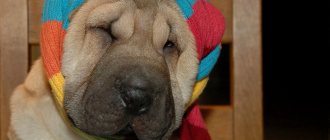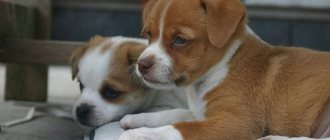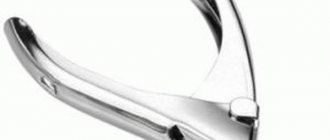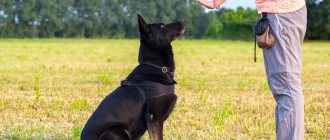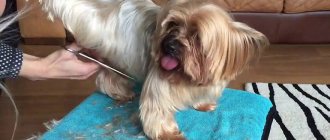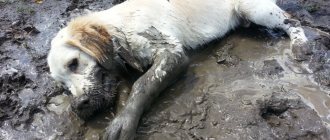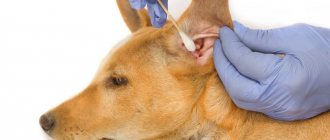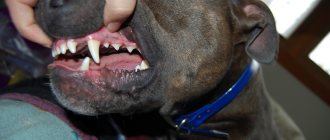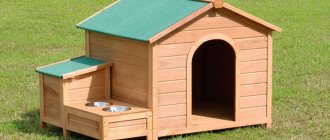Is it necessary to bathe a dog at all?
In fact, it is not at all necessary to do this regularly. There is no need to rinse off sweat, since dogs do not produce it, and the coat is capable of self-cleaning.
They resort to washing only as a last resort, if the dog is very dirty after a walk or smells of carrion (this happens with hunting breeds), according to indications from a veterinarian for skin diseases or the presence of parasites, as well as on the eve of an exhibition where the condition of the coat is assessed, and even after haircuts to wash off the remains of the cut wool.
Some owners wash their dogs because they sleep on the owner's bed or on the sofa. Of course, you want your pet to not smell of anything.
You should wash your paws every day after walks. And if your dog gets dirty with food during a meal, you can wash its face.
How often should you wash your dog unless it's an emergency? Veterinarians recommend doing this no more than once a month. In general, the frequency depends on the breed, length and structure of the coat. Some people need the procedure weekly, while others need it once every 2-3 months.
Breeds that require almost no water treatments
Some dogs need to be bathed less often than usual - only once every 2-4 months. These breeds include decorative and wire-haired breeds, as well as those with a thick undercoat:
- Bolonki (Bichons).
Due to their rare access to the street, these pets hardly get dirty, but still need professional care. Their luxurious coat is prone to tangling.
- Shih Tzu.
Like lap dogs, they only need to comb out debris from their fur and wipe their paws. The only caveat is the fluffy beard, which gets dirty after every meal.
- Continental Toy Spaniels (Papillon and Phalene).
Puddles and mud are diligently avoided on walks. The regularity of water procedures is increased only in the autumn-spring period.
- Terriers (Fox Terrier, Jack Russell Terrier).
It is more important not to wash these four-legged animals, but to comb and trim them. Otherwise, they quickly become covered with tangles.
- Labradors.
The double coat of these dogs has water- and dirt-repellent functions.
Don’t force yourself into strict limits and be sure to take into account the characteristics of your pet. Frequent water procedures are not always useful, and if there are contraindications, they are even dangerous. Remember this and do not wash your pet entirely unless absolutely necessary.
Do you like the article? 0
Which dogs are rarely washed?
There are decorative dog breeds. They are very small. They are carried outside in their arms, and they go to the toilet right in the house in a tray or on a diaper. Therefore, they are washed infrequently.
- Dogs with long, smooth hair prefer to be combed rather than washed. During the process, the wool is cleaned of contaminants.
- Dogs with thick undercoat that are constantly kept in an enclosure are washed only as a last resort. Their fur deteriorates from washing, and the sebaceous glands begin to malfunction.
- Puppies are not bathed until they begin walking regularly. As long as they are unfamiliar with the street, this is not necessary.
- You cannot wash your dog two days before vaccination and for 10 days after. If treatment for parasites is planned, then washing should be done a week before treatment, and repeated no earlier than a week later.
Nursing and pregnant dogs can only be washed if they tolerate the procedure well. If the animal is nervous, it is better to delay washing.
At what age can you bathe a puppy?
First, you should figure out at what age it is permissible to start carrying out water treatments for a puppy. Experts advise having the first bath when your pet is 3 months old. Newborn pets are licked by their mother. But if the puppy already lives separately from her, it is enough to wipe him with a damp cloth. It is still too small for a full wash.
You can start bathing your pet only after he is three months old.
If your pet previously lived on the street, then it should be bathed immediately. His age doesn't matter. But if he is not yet 3 months old, he should act with extreme caution. Additionally, in such a situation, the animal is treated with a special anti-flea drug. It's also best to take him to the vet.
If you adopted a pet from the street, it can be bathed at any age. It is at the age of 3 months that puppies are often purchased from breeders. You should not immediately take your pet to the bath. He will need time to get used to his new home. Therefore, it is recommended to postpone swimming for 2-3 weeks.
Which dogs are washed frequently?
There are breeds with thick and long hair: Newfoundlands, Bobtails, St. Bernards and others. Their fur gets dirty quite often and needs to be washed.
The same applies to white and light-colored dogs, as well as those whose skin has many folds - pugs, sharpeis.
- Show dogs, whose fur is very similar in texture to human hair, also need frequent bathing.
- Dogs have periods of shedding. The fur falls out and needs to be combed out, and the remains washed out with water and shampoo.
While walking, city dogs are more likely to bring home particles of exhaust gases, soot, and reagents than village dogs. Therefore, city dogs are washed more often.
Features and rules of hygiene
Every time you return after a walk, your dog needs to wipe its paws and belly. In muddy or rainy weather, wiping may not be enough. In this case, you can use the shower so that the dirt from your pet is not spread throughout the apartment. This simple daily procedure should not be confused with a full bath. No detergents are used during this type of washing. Pets of small breeds and puppies during the quarantine period (when bathing is strictly forbidden) that go to the litter box also need frequent washing of their paws.
It is necessary to accustom your dog to bathing from an early age, as soon as the last vaccinations according to age have been completed and quarantine has been lifted. This will help avoid fear of water in the future and make hygiene procedures simple and enjoyable for your pet and you. Prepare a treat to give your baby after bath time.
There are a few simple rules that will make swimming completely safe:
- Before bathing, inspect your pet for mats, wounds, rashes, or broken skin. Comb or remove any matted fur. If there are wounds or other skin lesions, delay bathing until they heal or the cause of their occurrence is determined.
- To make the dog comfortable, it is not afraid of moving and sliding paws, but can stand calmly - place a rubber mat in the bathtub or shower;
- The water should be warm, about 35°C, comfortable for your wrist. Water that is too cold will scare the dog, water that is too hot can cause harm and make bathing impossible, sometimes in the future too.
- The fur needs to be well wetted by simply watering the pet from the shower for a few minutes.
- Start lathering from the back, moving to the paws and chest. This must be done carefully and carefully. Wash your face last. This is often the least favorite part of bathing for dogs. Be careful not to let water get into your ears.
- You need to repeat soaping 2-3 times, each time thoroughly rinsing off the shampoo. Then you can use conditioner or balm (relevant for long-haired dogs).
- After washing, the dog must be thoroughly dried with a towel, be sure to pay attention to the ears.
- The apartment should be warm, avoid drafts. A wet dog can catch a cold.
- For long hair that is prone to tangling, comb it before bathing and then dry it with a hairdryer. The air stream, like water, should not be hot.
The process of bathing a dog
To wash your dog in the bath, you need to prepare for this process.
The preparation is as follows:
- Close all windows and doors to prevent drafts, otherwise the animal may catch a cold.
- Cover the bathroom floor with old rags to prevent your dog from slipping if he decides to jump out of the bath.
- It is also necessary to prevent the possibility of slipping in the bathtub itself by laying a rubber mat on its bottom.
- It is better for the owner to put on clothes that he doesn’t mind getting dirty or wet, and the pet can also cling to it and tear it.
- The dog's fur needs to be inspected, tangles should be cut off or combed, and the parasite collar should be removed.
- If a dog does not tolerate washing well and tries to bite, it is better to put a muzzle on it, and if it tries to jump out of the bath, then also a leash.
The bathing container is selected depending on the size of the dog. A large one can be placed in a bathtub, a small one in a baby bath, and dwarf breeds can be bathed in a basin. In the video on how to wash a dog, you can get acquainted with this procedure in detail, but you need to be prepared for various surprises.
The water temperature should be no lower than 35 degrees and no higher than 40. Hot water will be uncomfortable for the dog and can cause deterioration in the condition of the coat.
You need to pour water on the fur of a dog standing in the bath and wet it all. Avoid getting water into your ears and eyes. You can put earplugs in your ears. Dogs with cropped ears do not have their hair washed.
Beginning dog owners always have a question: is it possible to wash a dog with human shampoo?
- Veterinarians unequivocally answer that it is impossible, except perhaps in force majeure circumstances. Dogs and people have different pH levels.
- Human shampoo can cause allergies or hair loss in your pet.
- Therefore, you should stock up on several shampoos specifically for dogs, including antiparasitic ones.
- The shampoo is applied to the wool not directly from the bottle, but after diluting it with water: 1 part special shampoo, 5 parts water.
- You also need to wash your dog’s private parts. After thorough washing, you can rinse off the foam, especially from the armpits, skin folds and neck area.
- If it so happens that the dog gets very dirty during a walk or is found after several days of wandering on the street, you can re-soap it and rinse it again.
Once all the foam has been washed away and most of the water has drained away, you can apply conditioner (for dogs!) to a dog with long, smooth hair. After a certain time it must be washed off. This product makes it easier to comb the hair.
A dog that is bathing for the first time, and this can happen if it was taken from the street, needs to be encouraged in every possible way, not to make sudden movements, not to jerk, not to scream, and especially not to hit. Over time, she will get used to the procedure and will behave more calmly.
Features of washing dogs
Since not all dogs love water, washing can be a real stress for them. That is why the first bath of a dog is of great importance, which should form a positive experience for the animal. It is necessary that the washing procedure takes place in a comfortable environment with a person whom the dog knows and loves well. Ideally, this should be the dog's immediate owner. The choice of washing agent, water temperature, method of drying the wool, and the time of the procedure are of great importance. If you have any doubts about the correctness of your actions, be sure to consult your veterinarian. This is especially important if the dog belongs to a finicky breed, or has any chronic diseases.
How to dry a dog
The pet should be taken out of the bath by the owner, and not allowed to jump out.
- Firstly, she may run suddenly and slip.
- Secondly, then everything in the apartment will be in the water from the wool.
- Having taken the dog out, you need to put it on a towel and blot its fur with another towel.
- For a large dog, you will need several towels. Then let the wool dry naturally.
- As a last resort, use a hairdryer and turn it on at room temperature.
After the fur is completely dry, you need to comb it. If you do not wait until it dries completely, wet wool hairs will break. After washing your dog, it is advisable to walk him only a couple of hours later, as he may catch a cold from the temperature change.
How to wash a puppy
To protect the animal's fur from various pests, nature has awarded it with a special lubricant, which is secreted by the sebaceous glands. If you wash only with clean water without soap, the natural lubricant is not washed out. But when using soap solutions, all protection is lost. Therefore, it is necessary to choose special shampoos that are designed specifically for animal fur.
Without water procedures
In addition to bathing, dogs need daily grooming. This includes simple combing. It must be done to get rid of dust, dirt, tangled dry grass, as well as old peeling skin. During the period of seasonal molting, namely autumn and spring, there is no way to do without combing the fur. This is especially true for long-haired breeds. Large dogs, for example, a German shepherd, are best brushed outside, so as not to have to clean up the apartment with fur scattered all over the place.
In summer, in dry weather, a dusty body can be wiped with wet wipes. Or you can wet a washcloth and perform a massage, which is also beneficial for your pet’s skin. After this, wipe the fur dry with a towel. Then you can start combing. It is better to choose a metal comb with bent teeth.
What you will need
You need to stock up on these items for bath days in advance:
- For small breeds, a sink or basin is suitable. It is better to teach large breeds to take a bath straight away.
- A favorite treat to calm your dog down at the right time.
- Special shampoo for dogs, selected by age.
- Watering ladle.
- Several clean towels that you will only use to dry your dog. Afterwards, a person cannot use them, even if they are washed thoroughly.
- Brushes and combs for combing out dried wool; wet fur should not be combed.
Choosing a Shampoo
Specialized shampoos for animals are usually very different from human ones. They do not contain various flavored dyes, unknown substances that impart a strong specific odor, alkalis and other unnecessary additives. Dog detergents are made specifically for fur, not hair.
Good quality shampoos are certainly not cheap, but they last a long time, since dogs often do not wash themselves, unlike humans. Here are a few manufacturers that have proven themselves well: Hartz, Doctor Vic, 8in1, Tropiclean.
When looking for a shampoo, you need to take into account the dog's age, breed, coat type, as well as the purpose, for example, for fleas. Shampoo instructions and recommendations will help you make the right choice. Conditioners are usually purchased from the same brand and from the same line of detergent.
How to wash your paws after a walk
If it’s slushy outside, you have to wash your dog’s paws after every walk.
- To do this, you should leave a bowl of water and a towel in the hallway so that you can come in from outside and immediately wash your paws.
- And also fur on the belly if it gets into a puddle.
- After this, wipe the paws with a towel and, if necessary, lubricate with cream.
- It will help relieve discomfort if the dog gets scratches while walking, as well as if the skin is rough.
Post-swim care
After the procedure, many dogs begin to rush around the house, may tremble violently and try to climb into the owner’s arms. This is completely normal behavior. This is how the animal tries to keep warm. The owner can help the pet dry out faster. To do this, first, while still in the bath, the wool is squeezed out by hand. They wait until the dog shakes itself off on its own.
Then blot the fur with a towel. It is recommended to take a second towel that is dry, wrap your pet in it and leave for 15 minutes.
After bathing, you need to wrap your dog in a dry towel.
If the animal is not afraid of a hairdryer, you can use it to dry the fur. The method is suitable for the winter period; drying is carried out at the minimum speed of a hairdryer. When drying, comb the animal at the same time.
If it was not possible to avoid the formation of tangles, they are carefully cut out with scissors. For breeds with very short fur, it is recommended to apply a special moisturizing balm. It is worth noting that for the first few hours after bathing, you should not let your dog out onto the street or balcony.
The dog should not be allowed outside immediately after bathing.
What if the dog smells strongly?
How to wash a dog from the smell if it is pronounced?
- Dilute 1 tablespoon of vinegar in 250 ml of warm water, soak a sponge in the solution and wipe the animal’s fur with it.
- This method should only be used as a last resort, as it can dry out the dog’s fur and skin.
A very strong specific smell from a dog should alert you. This may be a symptom of a disease, which will be announced by the veterinarian at the clinic.
Now you know everything about how to wash a dog.
Is it possible to wash a dog that is afraid of water?
Many dogs are afraid of water if they have not been accustomed to bathing since childhood. Washing such an animal at home will cause a lot of trouble for its owners.
Steps to take when washing a dog that doesn’t like water:
- Teach your animal to perceive the bathroom as a safe place - organize feeding in this room.
- Then feed the dog directly in the bathtub. When your pet is no longer afraid of the bath, you can turn on the water briefly. Pet and praise her if she takes the water calmly.
- Then you can wet the dog. If she stands calmly and behaves well, treat her with a treat or give her her favorite toy.
- Don't rush it, teach it gradually to develop positive associations with washing.
Photo instructions on how and what to wash your dog with
How to get rid of dog smell?
Sometimes the question of washing an animal arises even after the appearance of an unpleasant dog odor from the animal - most often this is observed in the autumn and spring seasons. The cause of dog smell is the secretions of the skin glands, which protect the animal’s fur from harmful influences.
To avoid the smell of dog:
- Brush the fur - it is the undercoat that absorbs unpleasant odors.
- Use medicated dog shampoos designed to improve skin condition.
- You can wipe the wool with a special solution : vinegar, vodka and water are mixed in equal parts and wiped with a soft cloth soaked in this solution.
- Adjust your pet's diet - sometimes certain foods can cause dog odor.
- You can use odor neutralizers , which are sold in pet stores.
Does the dog shit in the house? Wash the floors!
Some dogs shit in the apartment due to the retention of their own urine odors on the floor coverings. To prevent floors from smelling like “dog,” it is best to thoroughly wash them with products that smell like bleach. This is whiteness , Domestos and other means. They should be diluted with water , and the floors should be thoroughly washed . Vinegar and potassium permanganate solution also help get rid of the smell .
Maintaining cleanliness and getting rid of unpleasant odors in the house where your four-legged friend lives is difficult, but quite possible. Teach your dog to behave civilly - not to climb on the sofa, to wash his paws after walks.
Watch where your friend walks - do not walk in the area of garbage containers (they really like unpleasant odors for us and will happily roll around in the garbage).
If you have a puppy, his training should include teaching him to bathe - while he is small, this is quite easy to do.
Add a comment Cancel reply
Bathing dries out your pet's skin
Dog breeders often experience dry skin on their pets. Some people think it's about bathing. But this is another misconception. Dry skin is caused by improper selection of hygiene products or the use of inappropriate products, improper feeding, diseases and vitamin deficiencies. A high-quality shampoo, selected taking into account the breed and health status, makes the pet’s coat soft and silky, removes dandruff and relieves itching and will never dry out the skin. But a lack of vitamins and fatty acids in the diet has a bad effect on the coat, even if the dog has never washed in his life.
If a dog's hair is falling out, dandruff has appeared, or the animal is prone to allergic reactions, then an experienced groomer will help you choose a shampoo that will eliminate these problems, and a veterinarian will help you find the cause and adjust the diet. To combat ectoparasites in dogs, professional protective equipment is used, which can be purchased at a pet pharmacy or veterinary clinic.
Watch out, sun!
The worst thing for a dog on the beach is overheating. To avoid this unpleasant phenomenon, do not allow her to run in the sun or lie in the shade. If there is no natural shade, then use an umbrella. Another technique that dog breeders use to prevent overheating is a wet bandage on the dog’s neck. Preventing heatstroke - going to the beach in the morning and evening.
The sun's rays are especially dangerous for decorative and short-haired breeds of dogs. Hairless canines are at risk of sunburn. Therefore, pack sunscreen in your beach bag.
It is useful for every dog owner to know the main symptoms of overheating:
- labored breathing;
- saliva flows profusely;
- nose dry and hot;
- wide eyes, glassy eyes.
When severely overheated, the dog vomits, cramps and diarrhea appear. Therefore, you should not spend a lot of time on the beach in extreme heat - no more than 2-3 hours. Remember that the older the dog, the more difficult it is to tolerate hot weather.
Don't force it if the dog doesn't like to bathe.
There is an opinion that if an animal does not like to bathe, snaps when its teeth or ears are brushed, its nails are trimmed, or other hygiene procedures are performed, you should leave the dog alone. This opinion is fundamentally wrong; animals can and should be trained to practice daily hygiene. It is important to do this regularly, preferably at the same time, and reward your pet with treats.
Over time, the pet gets used to being periodically bathed, then dried and combed, having its nails trimmed and teeth brushed. Then he stops rebelling. Be patient and persistent, do not punish the dog, but be firm in your intentions.
Before bathing, dogs are thoroughly combed and then their coat is moistened with warm water at 35–40 °C. Too cold or hot water can cause the dog to resist and become unwilling to take further water treatments. The animal should be comfortable; the stream from the shower should not be directed into the dog’s face, so as not to frighten or cause aggression. Puppies should be taught hygiene procedures from an early age.
Is it possible to visit the beach with a dog?
Before you take your pet to the beach, make sure you can get there. As a rule, at seaside resorts it is prohibited to bring a dog on the beach, but there are places specially designed for holidays with animals. If there is no prohibiting sign at the entrance, then formally there is no ban. But remember that there may be people next to you who are against such a neighborhood. It is better not to enter into conflict with them in order to avoid an administrative fine. Those who love four-legged animals also pose a danger to the dog - they can treat them to something prohibited.
To avoid conflicts with others, follow these recommendations:
- choose wild beaches for relaxing by the water with your dog;
- come early in the morning or late in the evening when there are few people;
- Be sure to take with you a leash, a muzzle, and a bag for cleaning up after your dog.
Remember, the owner is responsible if his dog causes harm to someone in a public place.
What is the optimal water temperature for a bath?
Many people tend to bathe their dogs in water that is too warm. This can be uncomfortable for the dog and, in some cases, dangerous. If the bath water is too warm, you may overheat your dog. Add a hot dryer to the mix and you can cause problems, especially with large breeds and overweight dogs that have a hard time cooling down.
For your dog's well-being, the water temperature should be a degree or two higher than his body temperature.
If the dog's temperature ranges from 38.5° to 39.2°, the water temperature should be around 40°. That is, it should be warm. This way we will avoid burns on the skin.
From time to time, you may notice your dog shaking while bathing. This suggests that she is cold and you are inclined to increase the temperature of the water.
© shutterstock
A dog may tremble for two reasons. On the one hand, because she is afraid and this causes those tremors, or because the ambient temperature is very low. Therefore, I recommend first conditioning the room in which you are going to bathe your dog, setting it to the same temperature as the water, or a little lower. That is, between 35º and 40º.
